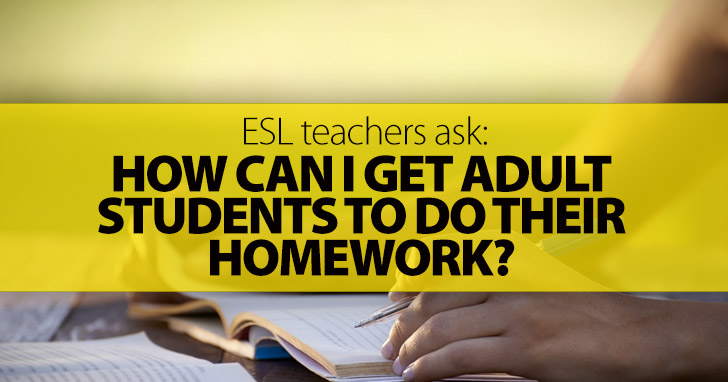ESL Teachers Ask: How Can I Get Adult Students to Do Their Homework?


“I have a group of very nice, polite adult learners, who meet the basic requirements for the course, but I would love it if they would participate more actively and with greater enthusiasm. How do I generate more enthusiasm? How can I increase student engagement?” *
Ahhh…if only adults or teens had the natural enthusiasm that young learners bring into the ESL classroom! If only they had the same energy and curiosity! If only they were as easy to engage! But they are certainly different. Teens are bogged down by preoccupations, from college applications to piles of homework from their other classes. With job and family responsibilities, adults also have a lot on their plate. Which is why they most often show up for class and hope they pass the course. Doesn’t sound very exciting, does it? But there are ways to get them excited and engaged in the ESL activities you present. And here’s how:

Students walk into the classroom, sit down, open their notebooks and get ready to take notes. And while note-taking is a fine strategy, you don’t want to launch into an explanation of the differences between the Simple Past and the Present Perfect as your students merely take notes. Talk about boring! And passive! Instead help students learn these differences through real-life examples:
T: Juan, how long did you live in Mexico before coming to the US?
S. I lived there for 20 years.
T: And when did you move to the US?
S: I moved here two years ago.
T: (Write down examples on the board) So, you lived in Mexico for 20 years. You have lived here for two.
Ask students if they see the difference between the two sentences (one refers to something that happened in the past and is finished while the other refers to something that started in the past but continues today).
Try to avoid explanations or reading from a grammar textbook while students copy down “the rules”. Try to use their own experiences and before giving them an answer, give them the opportunity to think. Engage your students’ thought processes to help them reach conclusions on their own.
Say your students have to “learn the Simple Past”. You walk into the classroom and say, “Class, today you’re going to learn the Simple Past.” And you’ll probably get a bunch of blank stares in return. Why would students care about the Simple Past? What they want is to “get a job”, “talk to their boss in English” or “connect to friends in other countries”. So, depending on the characteristics of each particular group of students, you can modify the general goal (learn verbs in past) to suit their own particular needs. Say, “Class, today you’re going to learn how to tell your friends about your holidays/talk to someone about your past job experience.” Sounds more interesting, doesn’t it?
No matter if you’re doing a reading, writing, listening or speaking activity, always make sure your students understand exactly what is expected of them. You tell your students to “Listen!”, right before a listening task. What exactly is it they have to listen for? Do they have to get the gist? What will they listen to? A conversation? A news report? Don’t be surprised if students tune out halfway through the listening…A simple indication to “listen” is not enough to engage your ESL learners. Instead, give them a specific task: You’ll hear a conversation between a customer and a waiter in a restaurant. Listen carefully and write down what the customer orders for lunch.
Chances are your ESL students are learning English because they want to communicate with others. They need opportunities to practice real-life interactions. Two-way gap- filling exercises, for example, are great. Or have students pair up, and give each a copy of their “weekly schedule” (naturally, each copy is completely different). Students must work together to set up an appointment.
S1: Are you free Friday morning?
S2: No, I have yoga class. Does Friday afternoon work for you?
S1: No, sorry. I have a meeting then. How about Monday morning?
Think of real-life problems your students could very likely face in a variety of areas, from buying a special gift to house hunting. Ask them to work together to decide the best option/solution for the problem. Try this house hunting scenario: give students two housing options. One is an apartment in the city and the other is a house in the suburbs; if they move to the suburbs they’ll have a longer commute but more peace and quiet. What will they do?
Take the real-life problem one step further and turn it into a full blown research project. Students could do research on a nearby town that is perfect for a weekend getaway. What hotels are there? What activities can you do there? How can you get there? Divide the class into teams. Each team member can research one of the aspects and then share the information with the rest of the team. Finally, the team puts together a presentation on the information they’ve gathered.
Can you tell what each of the points mentioned above have in common? They focus on real-life scenarios, common dilemmas, everyday problems that your students may face, and that is one the keys to ESL student engagement (together with making your lessons more fun). You can grab their attention with your tone of voice, jokes or overall sense of humor. But when they see the practical use of something they’re learning, you’ll have them engaged for the duration.
Share your strategies below!
* This question was sent in from a real ESL teacher, just like you! If you need any advice on a particular topic, share your question in the comments below. Or tweet your question to @busyteacher_org with the hashtag #ESLTeachersAsk. Your question might get picked and featured in an article!